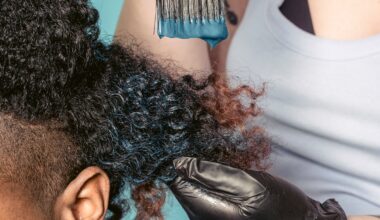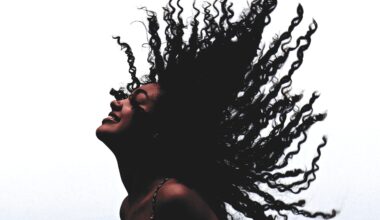Introduction
Hair straightening, a coveted procedure, offers the promise of silky, manageable, and straight hair, appealing to many who grapple with unruly or curly locks. However, as with most beauty treatments, there lurks a cloud of concern—does the quest for straight hair lead to hair loss? This pressing question has seen numerous discussions in beauty forums and even among professionals in the industry.
The curiosity stems from a place of care and caution, as hair is not just a matter of aesthetics, but a symbol of personal well-being and confidence. So, it’s only rational that individuals wish to understand the implications thoroughly before deciding on straightening their hair.
In this explorative article, we delve into the mechanics of hair straightening, understand the anatomy of hair loss, and unravel whether there’s a real cause for concern. Moreover, we aim to arm you with preventive measures and professional recommendations should you decide to tread the path of hair straightening.
Key Takeaways:
- Understanding the Hair Straightening Process: It’s crucial to grasp the intricacies of various straightening techniques, including the chemicals and heat involved, to appreciate their effects on hair health.
- Factors Leading to Hair Damage: Not all hair damage originates from straightening. External factors, lifestyle, and even genetics can play roles, but certain practices in straightening undeniably heighten risks.
- Preventive Measures to Safeguard Your Locks: It’s not all doom and gloom! With a clear understanding and proactive care, you can enjoy straightened hair without significant compromise on hair health.
- The Role of Professional Treatments and Quality Products: Not all straightening procedures are made equal. The importance of choosing trained professionals and high-quality products cannot be stressed enough.
With the takeaways clearly listed, readers can quickly gauge what to expect in the subsequent sections. They can anticipate solutions and guidance, not just information.
What is Hair Straightening?
For many, the lure of straight, manageable hair is hard to resist. The science of hair straightening, both fascinating and complex, has evolved considerably over the decades. At its core, straightening transforms the natural structure of your hair, making it appear straight. But how does it achieve this?
- The Basic Process: At a fundamental level, hair straightening operates by breaking down the hair’s natural bonds (often hydrogen bonds) using chemicals or heat. Once these bonds are broken, hair can be reshaped, and when it cools or settles, it assumes this new straight form.
- Different Types of Hair Straightening:
- Chemical Straightening (Also known as ‘relaxers’): This involves applying a chemical solution to hair. The chemicals penetrate the hair shaft, breaking specific bonds that make hair curly. After processing, the hair is neutralized to fix its new straight structure.
- Brazilian Straightening (or Keratin Treatment): A less permanent solution, this process involves coating hair with a liquid keratin and formaldehyde solution, followed by flat-ironing. The result? Shiny, almost-straight hair that lasts up to 2.5 months. Plus, it’s famous for reducing frizz.
- Japanese Straightening (or Thermal Reconditioning): This method is permanent. Hair is soaked in a chemical solution to break its bonds, then subjected to a flat iron to shape, and finally rinsed with a neutralizing solution.
- Heat-based Straightening: The simplest form, using heated tools like flat irons or blow dryers. This method is temporary, lasting until your next wash, but frequent usage can lead to damage.
- Safety Considerations: Not all methods suit all hair types. For instance, those with particularly fine or processed hair might find some chemical treatments too harsh. It’s vital to understand your hair’s condition and needs before choosing a method.
Hair straightening, as seen, is not just a singular method but a spectrum of techniques, each with its merits and potential concerns. With a foundation set on what hair straightening encompasses
The Science Behind Hair Loss:
To effectively discern whether hair straightening can induce hair loss, one must first grasp the fundamental science behind hair growth and the natural causes of hair fall.
- Anatomy of a Hair Strand and Its Growth Cycle:
- The Hair Follicle: Nestled under our skin is the hair follicle, a small organ responsible for producing our hair strands. Its health directly impacts the quality of the hair it produces.
- Growth Phases: Hair growth isn’t continuous but occurs in phases. The anagen phase is the growth phase, where hair cells rapidly divide and add to the hair shaft. This phase can last 2-7 years. Next, the catagen phase is a brief transitional stage lasting a few weeks. Finally, the telogen phase, which lasts about three months, is a resting period after which hair falls out, making way for new growth.
- Factors Contributing to Natural Hair Fall:
- Age: As we age, the anagen (growth) phase shortens, leading to thinner, shorter hair strands. This natural aging process can sometimes be mistaken for hair thinning from other causes.
- Genetics: Hereditary-pattern baldness is a natural condition caused by a combination of genetics, hormone levels, and the aging process.
- Diet and Nutrition: Deficiencies in essential nutrients like iron, vitamin D, and protein can contribute to increased hair fall.
- Hormonal Changes: Events like pregnancy, menopause, and even certain medications can disrupt hormonal balances, leading to temporary hair loss.
- External Factors: Excessive stress, certain hairstyles, and harsh hair care practices can also result in hair loss.
- Distinguishing Natural Fall from Damage-Induced Fall: It’s essential to realize that losing 50-100 hairs a day is standard for most people. But if you notice sudden or patchy hair loss or more significant than usual hair loss, it could be due to external factors, including harsh hair treatments.
With a foundational understanding of why hair naturally falls out and the lifecycle of hair growth, it becomes clearer to see how external treatments like hair straightening might play a role in the hair loss narrative.
The Potential Damages from Hair Straightening:
Hair straightening, while delivering polished, silky locks, comes with its potential pitfalls. While not everyone will experience adverse effects, it’s important to be well-informed about potential damages to make educated choices.
- Chemical Damage:
- Altering Hair Structure: Chemical treatments break the natural bonds within the hair shaft. Although this achieves the straightening effect, it can weaken the hair’s structural integrity, making it more prone to breakage.
- Dryness and Porosity: Chemicals can strip hair of its natural oils, making it drier and more porous. Porous hair tends to absorb and release moisture quickly, making it more vulnerable to frizz and further damage.
- Scalp Irritation: Chemical relaxers can sometimes cause burns or irritations if left on for too long or if applied incorrectly.
- Heat Damage:
- Dehydration: Excessive use of heat tools can deplete your hair of moisture, making it brittle and prone to breakage. Dehydrated hair lacks luster and can look dull.
- Split Ends: Prolonged and frequent exposure to high temperatures can lead to split ends. Once the hair starts splitting, the only real remedy is to trim it.
- Weakening of Hair Proteins: Heat can weaken the proteins that give hair its strength. This not only leads to breakage but can also result in a loss of curl for those with naturally curly hair.
- Exacerbating Existing Issues: If your hair is already damaged, say from coloring or previous chemical treatments, adding straightening into the mix can compound the damage. Layering treatments without giving hair ample time to recover can escalate hair health issues.
- Misconceptions about Hair Fall: While hair straightening can cause hair breakage due to the damage discussed, it’s different from actual hair loss from the roots. Breakage involves bits of hair snapping off, while hair loss involves entire strands, including the root, falling out.
Having uncovered the potential risks of hair straightening, it becomes imperative to arm oneself with protective strategies. Knowledge is power, and knowing how to protect and care for straightened hair can make all the difference.
Protective Strategies and Care for Straightened Hair:
Safeguarding your hair from potential damages associated with straightening requires both pre-treatment precautions and post-treatment care. Here’s how you can make the most of your straightened hair while keeping it healthy:
- Pre-Treatment Preparations:
- Deep Conditioning: Before subjecting your hair to chemicals or heat, ensure it’s well-nourished. Deep condition your hair a week in advance to hydrate and strengthen it.
- Protein Treatments: These can reinforce hair structure, making it more resilient to the upcoming process.
- Scalp Protection: If you’re going for a chemical treatment, apply an oil or protective base to your scalp to reduce the risk of irritation.
- Choosing the Right Method:
- Know Your Hair: Understand your hair type and choose a straightening method that complements it. For instance, those with very fine hair might want to steer clear of harsh chemicals.
- Consult Professionals: Before committing, have a thorough consultation with a hairstylist. They can advise on the best method and potential outcomes based on your hair’s health and history.
- Post-Treatment Care:
- Avoid Over-Washing: Excessive washing can strip chemically treated hair of essential oils. Stick to 2-3 times a week and consider using a sulfate-free shampoo.
- Deep Conditioning: Continue with regular deep conditioning treatments to replenish lost moisture.
- Heat Protectants: If you need to use heat tools post-treatment, always use a heat protectant spray. It forms a barrier that minimizes direct heat damage.
- Regular Trims: To keep your hair looking fresh and free from split ends, schedule regular trims.
- Diversify Your Routine:
- Alternate Methods: Instead of continuously chemically treating or flat ironing your hair, consider alternative straightening methods occasionally, like using straightening brushes or hair wrapping techniques.
- Breaks Between Treatments: If you chemically straighten your hair, wait at least 6-8 weeks between touch-ups to give your hair a rest.
- Maintain Overall Hair Health:
- Balanced Diet: Ensure you’re consuming a diet rich in proteins, vitamins, and essential minerals for healthy hair growth.
- Scalp Massages: Regularly massaging your scalp with beneficial oils like coconut or jojoba oil can stimulate blood flow, promoting healthier hair.
- Limit Other Treatments: Try to avoid overlapping hair treatments. For instance, if you’ve recently colored your hair, wait a while before straightening.
Armed with these protective strategies, you can enjoy the benefits of straightened hair while mitigating the risks of potential damage. Always remember: the foundation of beautiful hair is its health.
Conclusion:
Hair straightening, whether achieved through heat or chemical means, offers the allure of sleek, polished locks. However, like any beauty procedure, it comes with its set of challenges. While the transformation can be striking, understanding potential risks and adopting preventive measures is key to enjoying the rewards while minimizing the pitfalls.
To reiterate:
- Differentiating Between Hair Breakage and Hair Loss: It’s crucial to discern between hair breakage resulting from the straightening process and genuine hair loss from the roots. Breakage might present as shorter, broken strands, while hair loss would involve the loss of full-length strands, often including the root. It’s the former that’s commonly associated with hair straightening.
- Empowerment Through Knowledge: Being aware of potential damages allows you to make informed decisions. Whether it’s choosing the right straightening method, selecting a skilled professional, or deciding on post-treatment care, knowledge is indeed power.
- Balancing Beauty with Health: While the quest for beauty often involves experimentation and transformation, prioritizing hair health ensures that beauty doesn’t come at an undue cost. After all, healthy hair is, in itself, a significant beauty asset.
Ultimately, hair straightening, when approached with caution and care, can offer a delightful change. But it’s vital to remember that the journey doesn’t end post-treatment. With consistent care, protective measures, and perhaps a touch of pampering, your straightened tresses can remain a source of pride and joy.
Whether you’re contemplating straightening your hair for the first time or are a seasoned enthusiast, may this guide serve as a roadmap to healthier, happier hair. After all, in the world of hair care, a little foresight goes a long way. Cheers to beautiful, straight, and strong locks!






